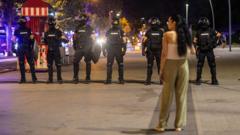As Serbia's anti-corruption protests progress into their ninth month, they are evolving in response to unmet demands for new elections. In a pivotal moment from last weekend's protest, which saw an impressive turnout of 140,000 in Belgrade's Slavija Square, student leaders announced their decision to step back from leading the rallies. This followed their ultimatum for the government to call elections, which was disregarded. They have since inspired a shift toward "civil disobedience," inviting other groups to take charge of future protests against President Aleksandar Vucic and his Progressive Party (SNS).
In the wake of this leadership change, roadblocks began to materialize across cities in Serbia, utilizing everyday items like dustbins and chairs to obstruct key intersections in places such as Belgrade, Novi Sad, and Nis. Local citizens' assemblies have played a central role, actively supporting these new methods of protest. The rapid establishment of blockades has met with police resistance; officers dismantle one blockade, only for another to arise soon after.
The policing of these demonstrations has drawn criticism and led to numerous arrests, raising concerns over excessive force. Recent clashes resulted in injuries, including broken bones suffered by students at Belgrade University's Law Faculty, as police confrontations intensified. These actions prompted protests from parents and resulted in widespread condemnation from various groups, including journalists, legal associations, and even the Serbian Orthodox Church. The European Union has voiced its disapproval of the violence, urging for tranquility amidst rising tensions.
Despite the growing confusion and frustration among commuters with disruptive blockades, some participants liken the gatherings to festive street parties instead of protests. Observers remain skeptical that these new strategies will yield better results compared to the earlier, larger rallies and sit-ins.
The origins of these protests trace back to a tragedy at Novi Sad railway station last November, where the collapse of a concrete canopy led to 16 fatalities. This incident sparked an outcry for political accountability, with students leading demands for transparency and justice. Though protests succeeded in forcing the resignation of prime minister Milos Vucevic, concerns linger about the efficacy of simply replacing government officials without genuine reform.
The current protest movement has garnered widespread participation and appears to be uniting disparate segments of Serbian society. Opponents of Vucic's regime draw parallels with the successful protests against Slobodan Milosevic two decades ago, which catalyzed democratic reforms. However, the political landscape remains challenging, with recent polls suggesting that Vucic's party maintains substantial public support.
As the roadblocks continue into a hot summer, the pivotal question remains: which side will yield first? With Vucic asserting that there will be no elections until December of next year, citizens remain determined in their fight for democratic changes through the ballot box, though uncertainty looms over potential opposition candidates.




















